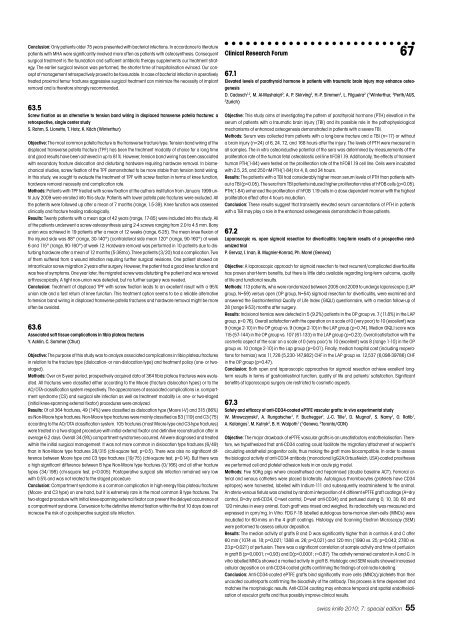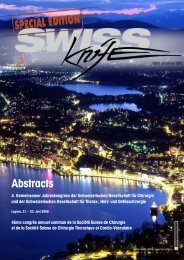Anorectal Manometry in 3D NEW! - Swiss-knife.org
Anorectal Manometry in 3D NEW! - Swiss-knife.org
Anorectal Manometry in 3D NEW! - Swiss-knife.org
Create successful ePaper yourself
Turn your PDF publications into a flip-book with our unique Google optimized e-Paper software.
Conclusion: Only patients older 75 years presented with bacterial <strong>in</strong>fections. In accordance to literature<br />
patients with MHA were significantly <strong>in</strong>volved more often as patients with osteosynthesis. Consequent<br />
surgical treatment is the foundation and sufficient antibiotic therapy supplements our treatment strategy.<br />
The earlier surgical revision was performed, the shorter time of hospitalisation ev<strong>in</strong>ced. Our concept<br />
of management retrospectively proved to be favourable. In case of bacterial <strong>in</strong>fection <strong>in</strong> operatively<br />
treated proximal femur fractures aggressive surgical treatment can m<strong>in</strong>imize the necessity of implant<br />
removal and is therefore strongly recommended.<br />
63.5<br />
Screw fixation as an alternative to tension band wir<strong>in</strong>g <strong>in</strong> displaced transverse patella fractures: a<br />
retrospective, s<strong>in</strong>gle center study<br />
S. Rahm, S. Lionetto, T. Hotz, K. Käch (W<strong>in</strong>terthur)<br />
Objective: The most common patella fracture is the transverse fracture type. Tension band wir<strong>in</strong>g of the<br />
displaced transverse patella fracture (TPF) has been the treatment modality of choice for a long time<br />
and good results have been achieved <strong>in</strong> up to 81%. However, tension band wir<strong>in</strong>g has been associated<br />
with secondary fracture dislocation and disturb<strong>in</strong>g hardware requir<strong>in</strong>g hardware removal. In biomechanical<br />
studies, screw fixation of the TPF demonstrated to be more stable than tension band wir<strong>in</strong>g.<br />
In this study, we sought to evaluate the treatment of TPF with screw fixation <strong>in</strong> terms of knee function,<br />
hardware removal necessity and complication rate.<br />
Methods: Patients with TPF treated with screw fixation at the authors <strong>in</strong>stitution from January 1999 until<br />
July 2009 were enrolled <strong>in</strong>to this study. Patients with lower patella pole fractures were excluded. All<br />
the patients were followed up after a mean of 7 months (range, 1.5-39). Knee function was assessed<br />
cl<strong>in</strong>ically and fracture heal<strong>in</strong>g radiologically.<br />
Results: Twenty patients with a mean age of 42 years (range, 17-85) were <strong>in</strong>cluded <strong>in</strong>to this study. All<br />
of the patients underwent a screw-osteosynthesis us<strong>in</strong>g 2-4 screws rang<strong>in</strong>g from 2.0 to 4.5 mm. Bony<br />
union was achieved <strong>in</strong> 19 patients after a mean of 12 weeks (range, 6-25). The mean knee flexion of<br />
the <strong>in</strong>jured side was 88° (range, 30-140°) (contralateral side mean 120° (range, 90-160°) at week<br />
6 and 115° (range, 90-160°) at week 12. Hardware removal was performed <strong>in</strong> 10 patients due to disturb<strong>in</strong>g<br />
hardware after a mean of 12 months (5-38mo). Three patients (3/20) had a complication. Two<br />
of them suffered from a wound <strong>in</strong>fection requir<strong>in</strong>g further surgical revisions. One patient showed an<br />
<strong>in</strong>traarticular screw migration 2 years after surgery. However, the patient had a good knee function and<br />
was free of symptoms. One year later, the migrated screw was disturb<strong>in</strong>g the patient and was removed<br />
arthroscopically. A tight non-union was detected, but no further surgery was needed.<br />
Conclusion: Treatment of displaced TPF with screw fixation leads to an excellent result with a 95%<br />
union rate and a fast return of knee function. This treatment option seems to be a reliable alternative<br />
to tension band wir<strong>in</strong>g <strong>in</strong> displaced transverse patella fractures and hardware removal might be more<br />
often be avoided.<br />
63.6<br />
Associated soft tissue complications <strong>in</strong> tibia plateau fractures<br />
Y. Ackl<strong>in</strong>, C. Sommer (Chur)<br />
Objective: The purpose of this study was to analyze associated complications <strong>in</strong> tibia plateau fractures<br />
<strong>in</strong> relation to the fracture type (dislocation- or non-dislocation-type) and treatment policy (one- or twostaged).<br />
Methods: Over an 8-year period, prospectively acquired data of 364 tibia plateau fractures were evaluated.<br />
All fractures were classified either accord<strong>in</strong>g to the Moore (fracture dislocation types) or to the<br />
AO/OTA-classification system respectively. The appearances of associated complications i.e. compartment<br />
syndrome (CS) and surgical site <strong>in</strong>fection as well as treatment modality i.e. one- or two-staged<br />
(<strong>in</strong>itial knee-spann<strong>in</strong>g external fixator) procedures were analyzed.<br />
Results: Of all 364 fractures, 49 (14%) were classified as dislocation type (Moore I-V) and 315 (86%)<br />
as Non-Moore type fractures. Non-Moore type fractures were ma<strong>in</strong>ly classified as B3 (119) and C3 (75)<br />
accord<strong>in</strong>g to the AO/OTA classification system. 105 fractures (most Moore-type and C3-type fractures)<br />
were treated <strong>in</strong> a two-staged procedure with <strong>in</strong>itial external fixator and def<strong>in</strong>itive reconstruction after <strong>in</strong><br />
average 6.2 days. Overall 34 (9%) compartment syndromes occurred. All were diagnosed and treated<br />
with<strong>in</strong> the <strong>in</strong>itial surgical management. It was not more common <strong>in</strong> dislocation type fractures (6/49)<br />
than <strong>in</strong> Non-Moore type fractures 28/315 (chi-square test, p=0.5). There was also no significant difference<br />
between Moore type and C3 type fractures (19/75) (chi-square test, p=0.14). But there was<br />
a high significant difference between B type Non-Moore type fractures (0/166) and all other fracture<br />
types (34/198) (chi-square test, p
















